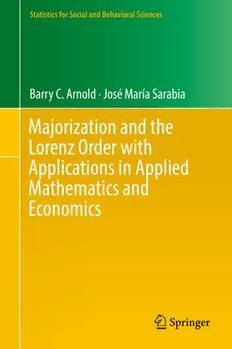Table Of ContentStatistics for Social and Behavioral Sciences
Barry C. Arnold · José María Sarabia
Majorization and the
Lorenz Order with
Applications in Applied
Mathematics and
Economics
Statistics for Social and Behavioral Sciences
SeriesEditor
StephenE.Fienberg(inmemorium)
CarnegieMellonUniversity,Pittsburgh,Pennsylvania,USA
Moreinformationaboutthisseriesathttp://www.springernature.com/series/3463
Barry C. Arnold • José María Sarabia
Majorization and the Lorenz
Order with Applications
in Applied Mathematics
and Economics
123
BarryC.Arnold JoséMaríaSarabia
DepartmentofStatistics DepartmentofEconomics
UniversityofCalifornia UniversityofCantabria
Riverside,CA,USA Santander,Spain
ISSN2199-7357 ISSN2199-7365 (electronic)
StatisticsforSocialandBehavioralSciences
ISBN978-3-319-93772-4 ISBN978-3-319-93773-1 (eBook)
https://doi.org/10.1007/978-3-319-93773-1
LibraryofCongressControlNumber:2018944630
©SpringerInternationalPublishingAG,partofSpringerNature2018
Thisworkissubjecttocopyright.AllrightsarereservedbythePublisher,whetherthewholeorpartof
thematerialisconcerned,specificallytherightsoftranslation,reprinting,reuseofillustrations,recitation,
broadcasting,reproductiononmicrofilmsorinanyotherphysicalway,andtransmissionorinformation
storageandretrieval,electronicadaptation,computersoftware,orbysimilarordissimilarmethodology
nowknownorhereafterdeveloped.
Theuseofgeneraldescriptivenames,registerednames,trademarks,servicemarks,etc.inthispublication
doesnotimply,evenintheabsenceofaspecificstatement,thatsuchnamesareexemptfromtherelevant
protectivelawsandregulationsandthereforefreeforgeneraluse.
Thepublisher,theauthors,andtheeditorsaresafetoassumethattheadviceandinformationinthisbook
arebelievedtobetrueandaccurateatthedateofpublication.Neitherthepublishernortheauthorsor
theeditorsgiveawarranty,expressorimplied,withrespecttothematerialcontainedhereinorforany
errorsoromissionsthatmayhavebeenmade.Thepublisherremainsneutralwithregardtojurisdictional
claimsinpublishedmapsandinstitutionalaffiliations.
ThisSpringerimprintispublishedbytheregisteredcompanySpringerInternationalPublishingAGpart
ofSpringerNature.
Theregisteredcompanyaddressis:Gewerbestrasse11,6330Cham,Switzerland
ToDarrel,LisaandKaelyn(BCA)
ToCori,JoséMaríaandBelén(JMS)
Preface to the Second Edition
In the 31 years since the first edition was published, there has been considerable
growth in the volume of research dealing with inequality and the Lorenz order.
This is especially true, quite naturally in the Econometrics literature. Robin Hood
retains a significant presence, and majorization still provides strong motivation
for consideration of Lorenz curves in discussions of inequality. There has been
significant growth in the number of summary measures of inequality that are now
considered,andmuchmoreattentionisnowpaidtodiscussionofflexibleparametric
familiesofLorenzcurves.Inthepresentedition,suchissuesareaddressedinsome
depth in Chaps.5, 6 and 10. In the current Chap.7 will be found a more detailed
discussionofmultivariateLorenzorderingthanwasincludedinChap.5ofthefirst
edition. The important concept of a Lorenz zonoid is prominent in the discussion.
Alternative Lorenz surfaces are also considered. The first edition ended with a
chapterwhichincludedapotpourriofsituationsinwhich,sometimessurprisingly,
majorizationand/orLorenzorderingplayedan,oftenimportant,roleintheanalysis.
Overtheyears,thenumberofsuchexampleshasnaturallyincreased.Therewereten
examplesofsuchapplicationsinthefinalchapterofthefirstedition.Therearenow
24,spreadovertwochapters.Theseexamplesreinforcethebeliefthatmajorization
and Lorenz ordering continue to find new areas of application often only faintly
related to income inequality but where variability comparisons are of importance.
Going back to our hero, Robin Hood, pictured on page 7, wherever inequality (or
variability)istobefound,RobinHoodwillappear.
We are grateful to many colleagues for helpful discussion of material in this
book, and we are grateful to the editorial staff of Springer for their patience and
encouragementwhilethebookwasdeveloping.
Riverside,CA,USA BarryC.Arnold
Santander,Cantabria,Spain JoséMaríaSarabia
March21,2018
vii
Preface to the First Edition
My interest in majorization was first spurred by Ingram Olkin’s proclivity for
finding Schur convex functions lurking in the problem section of every issue of
theAmericanMathematicalMonthly.Latermyinterestinincomeinequalityledme
again to try and “really” understand Hardy, Littlewood and Polya’s contributions
to the majorization literature. I have found the income distribution context to be
quite convenient for discussion of inequality orderings. The present set of notes
isdesignedforaonequartercourseintroducingmajorizationandtheLorenzorder.
TheinequalityprinciplesofDalton,especiallythetransferorRobinHoodprinciple,
aregivenappropriateprominence.
Initial versions of this material were used in graduate statistics classes taught
at the Colegio de Postgraduados, Montecillos, Mexico, and the University of
California,Riverside.Iamgratefultostudentsintheseclassesfortheirconstructive
critical commentaries. My wife Carole made noble efforts to harness my free-
form writing and punctuation. Occasionally I was unmoved by her requests for
clarification. Time will probably prove her right in these instances also. Peggy
Franklin did an outstanding job of typing the manuscript, and patiently endured
requestsforinnumerablemodifications.
Riverside,CA,USA BarryC.Arnold
July1986
ix
Contents
1 Introduction................................................................. 1
1.1 EarlyWorkAboutMajorization.................................... 1
1.2 TheDefinitionofMajorization..................................... 5
2 MajorizationinR+n ......................................................... 9
2.1 BasicResult......................................................... 9
2.2 SchurConvexFunctionsandMajorization........................ 13
2.3 Exercises ............................................................ 21
3 TheLorenzOrderintheSpaceofDistributionFunctions............. 23
3.1 TheLorenzCurve................................................... 24
3.2 TheLorenzOrder................................................... 27
3.3 Exercises ............................................................ 32
4 TransformationsandTheirEffects....................................... 35
4.1 DeterministicTransformations..................................... 35
4.2 StochasticTransformations......................................... 38
4.3 Exercises ............................................................ 41
5 InequalityMeasures........................................................ 45
5.1 Introduction ......................................................... 45
5.2 CommonMeasuresofInequality .................................. 46
5.2.1 SevenBasicInequalityMeasures......................... 46
5.2.2 InequalityMeasuresBasedontheConceptofEntropy . 49
5.3 InequalityMeasuresDerivedfromtheLorenzCurve............. 51
5.3.1 TheGiniIndex ............................................ 51
5.3.2 GeneralizationsoftheGiniIndex ........................ 54
5.3.3 DecompositionoftheGiniandYitzhakiIndices ........ 56
5.3.4 InequalityIndicesRelatedtoLorenzCurveMoments .. 61
5.3.5 ThePietraIndex........................................... 63
5.3.6 The Palma Index and Income Share Ratios
InequalityIndices ......................................... 66
xi
xii Contents
5.3.7 TheAmatoIndex.......................................... 67
5.3.8 TheEltetoandFrigyesInequalityMeasures............. 68
5.4 TheAtkinsonandtheGeneralizedEntropyIndices............... 69
5.4.1 TheAtkinsonIndices ..................................... 70
5.4.2 TheGeneralizedEntropyIndicesandtheTheilIndices. 70
5.4.3 DecomposabilityofCertainIndices...................... 72
5.5 EstimationwithPartialInformation................................ 77
5.5.1 BoundsontheGiniIndex................................. 77
5.5.2 Parameter Identification Using the Mean
andtheGiniIndex......................................... 78
5.6 MomentDistributions .............................................. 80
5.7 RelationsBetweenInequalityMeasures........................... 82
5.8 SampleVersionsofAnalyticMeasuresofInequality............. 83
5.8.1 AbsoluteandRelativeMeanDeviationandthe
SamplePietraIndex....................................... 83
5.8.2 TheSampleAmatoandBonferroniIndices.............. 85
5.8.3 TheSampleStandardDeviationandCoefficient
ofVariation................................................ 86
5.8.4 Gini’sMeanDifference................................... 87
5.8.5 TheSampleGiniIndex ................................... 89
5.8.6 SampleLorenzCurve..................................... 91
5.8.7 BiasoftheSampleLorenzCurveandGiniIndex....... 93
5.8.8 AsymptoticDistributionofLorenzOrdinates
andIncomeShares ........................................ 97
5.8.9 TheEltetoandFrigyesIndices ........................... 101
5.8.10 FurtherClassicalSampleMeasuresofInequality ....... 102
5.8.11 TheSampleAtkinsonandGeneralizedEntropyIndices 105
5.8.12 TheKolmInequalityIndices ............................. 108
5.8.13 AdditionalSampleInequalityIndices.................... 108
5.9 ANewClassofInequalityMeasures .............................. 109
5.10 Exercises ............................................................ 111
6 FamiliesofLorenzCurves................................................. 115
6.1 BasicResults........................................................ 115
6.1.1 ACharacterizationoftheLorenzCurve ................. 116
6.1.2 LorenzCurvesofSomeCommonDistributions......... 116
6.1.3 TranslatedandTruncatedLorenzCurves................ 117
6.1.4 TheModalityoftheIncomeDensityFunction .......... 119
6.2 TheAlchemyofLorenzCurves.................................... 120
6.3 ParametricFamiliesofLorenzCurves............................. 122
6.3.1 SomeHierarchicalFamilies .............................. 123
6.3.2 GeneralQuadraticLorenzCurves........................ 124
6.3.3 OtherParametricFamilies................................ 128

